Lazio Tours
Roman Villas | Etruscan, Ostia Antica | The Roman Castles | Ciociaria
Ciociaria Tour (My Home Land)
Lazio is a region home not only to Rome, Italy’s majestic Capital city, but also to a coast lined with fabulous bathing resorts and a countryside scattered with enchanting little towns and villages. For centuries one of the world's most important tourist destinations, Rome is Lazio's pride and joy: an immense treasure chest brimming with great works of art and architecture all of which testify to the city’s glorious past. Here in just a few square kilometres, any number of monuments constructed by the ancient Romans can be found, together with a staggering quantity of masterpieces created by the gifted artists of the Italian Renaissance. In the summer, the seaside resorts on the coast of Lazio, from Sabaudia to the Pontine islands, draw holiday makers from near and far, all eager to bathe in the sunshine and take a dip in the crystal clear sea. Then there are the region’s woods, lakes, thermal waters, Mount Terminillo and the Etruscan cities of Tarquinia and Cerveteri. Inland surrounded by the spectacular scenery of the Castelli Romani and the Ciociaria, it is easy to find towns where centuries-old popular traditions are still passionately observed, towns such as Viterbo, Fiuggi and Tivoli.
Suggested day tour of the surroundings of Rome in to the area called the Ciociaria, with the visit of Cassino, Fiuggi, Fumone, Anagni and Subiaco, the service is driver/guided and is individually personalized.
Roman Villas | Etruscan, Ostia Antica | The Roman Castles | Ciociaria
Ciociaria Tour (My Home Land)
Lazio is a region home not only to Rome, Italy’s majestic Capital city, but also to a coast lined with fabulous bathing resorts and a countryside scattered with enchanting little towns and villages. For centuries one of the world's most important tourist destinations, Rome is Lazio's pride and joy: an immense treasure chest brimming with great works of art and architecture all of which testify to the city’s glorious past. Here in just a few square kilometres, any number of monuments constructed by the ancient Romans can be found, together with a staggering quantity of masterpieces created by the gifted artists of the Italian Renaissance. In the summer, the seaside resorts on the coast of Lazio, from Sabaudia to the Pontine islands, draw holiday makers from near and far, all eager to bathe in the sunshine and take a dip in the crystal clear sea. Then there are the region’s woods, lakes, thermal waters, Mount Terminillo and the Etruscan cities of Tarquinia and Cerveteri. Inland surrounded by the spectacular scenery of the Castelli Romani and the Ciociaria, it is easy to find towns where centuries-old popular traditions are still passionately observed, towns such as Viterbo, Fiuggi and Tivoli.
Suggested day tour of the surroundings of Rome in to the area called the Ciociaria, with the visit of Cassino, Fiuggi, Fumone, Anagni and Subiaco, the service is driver/guided and is individually personalized.
| Fiuggi. The medieval hill top town of Fiuggi, situated in the area called the Ciociaria, in the province of Frosinone, is one of Europe's most important thermal centres. Since the 1300's, when Pope Boniface VIII celebrated his liberation from excruciatingly painful kidney stones here, Fiuggi has boasted a reputation for the health inducing properties of its mineral waters. The great Michelangelo claimed that the waters of Fiuggi had relieved him of "the only kind of stone I couldn't love." In addition to enjoying treatments in Fiuggi's state-of-the-art spas, visitors to the town have the opportunity to partake in any number of sporting activities, from golf to horse riding, swimming to mountain biking. Fiuggi is also a great place to shop, and is home to numerous art galleries. Above the 20th century spa town known as Fiuggi Fonte, lies the picturesque town of Fiuggi Città which, with its incredibly narrow medieval streets and alleys, is best visited on foot. The "Vicolo Baciadonne" is so narrow that pedestrians are obliged to pass within kissing distance of each other. A tour of the town might well start with the Piazza dell'Olmo, home to the Church of San Pietro and Palazzo Falconi. Then there are the two magnificent edifices built in Italian liberty style, the old Casinò, which now serves as Town Hall, and the Grand Hotel, in which to find one of the most prestigious hotel schools in Italy. A few kilometres away from Fiuggi lies the Natural Oasis of Fiuggi and Lake Canterno, sites which will delight nature lovers and, in particular, fishing enthusiasts. |
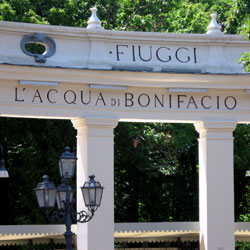 |
| Fumone. The small village of Fumone is built on top of a hill( 750 metres), overlooks more than forty-five surrounding villages. It is very picturesque and worthy to be visited is the Castle of Fumone. Its documented history goes back to the 10th century and is closely linked with the history of the church. Used for over five hundred years as an advance defence post to the south of Rome, and as a Papal prison. The most famous prisoner was Celestino V, the only Pope in history to have abdicated only a few months as Supreme Pontiff, he was imprisoned at Fumone Castle by Bonifacio VIII in 1295 and died there. All attempt to capture the Castle by force were notable failures, even the Emperor Henry VI and Barbarossa did not succeed. In 1584 the Longhi family descendants of Bonifacio VIII bought the Castle and converted it to a private residence. In 1600 they constructed a remarkable hanging garden on top of the battlements. |
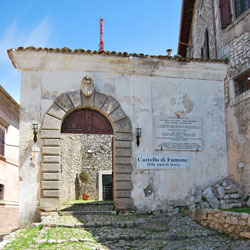 |
| Anagni. The town of Anagni is well known as town of the Popes, as it was native land to four Popes ( Innocenzo III, Gregorio IX, Alessandro IV, Bonifacio VIII). On the site of the ancient Acropolis, stands the Cathedral ( 1074-1195), one of the most important Romanesque stile in Lazio. The Crypt is particulary interesting, with thirteenth century cosmati floor and beautiful frescos done in the Byzantine tradition by Benedectine artists. It is also called the “Sistine Chapel” of 1200 century. Near the Cathedral to visit is the Palace of Bonifacio VIII, built at the end of the thirteenth century, known for the slap to the Pope, by William Nogaret, chancellor of the King of France. Other important mediaeval buildings are the Town Hall and the church of St. Andrew with a precious fourteenth century triptych. |
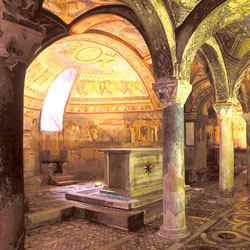 |
| Subiaco. Subiaco is world famous for the monasteries of St. Benedict and his sister St. Scolastica. The monastery of St. Benedict is a fascinating picturesque group of buildings perched on the rock, near the Sacro Speco, the cave where St. Benedict lived and hermit, construction began in the 13th century. The Abbey of the St. Scolastica is a vast ponderous complex of constructions built around three cloisters dating back to different periods. Noteworthy also is the library of the monastery of St. Scolastica, which contains 35.000 books, 380 manuscripts and 212 incunabula published here by the first printing in Italy (1465). It was in Subiaco that Benedict, in the 5th century, drew up the rules for the Benedictine Order, in the 529 he transferred to Cassino where he founded the Abbey of Montecassino. Other points of interest are the remains of the Villa that the Emperor Nero built, the church of St. Francesco (14th century), the church of St. Andrea and St.Pietro, with 12th century Romanesque tower, the bridge of St. Francesco and the house. Lucrezia Borgia. ( She was born in this house 18-April-1480). |
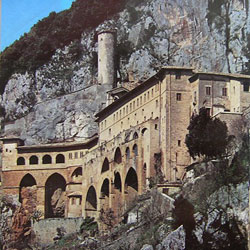 |
| Cassino. The town of Cassino, in the province of Frosinone, is home to one of Italy's most visited monuments, the Abbey of Montecassino. Result of the transformation of a pagan temple in Monastery dedicated to Saint Martin, the construction of the abbey was completed in 529 and supervised by Benedetto da Norcia, who composed his Benedictine order here, best summarised in the Latin “Ora et Labora" (pray and work). Over the centuries, the appearance of the Abbey has been altered on various occasions, the last major intervention being made following the world war II bombing of 1944, which almost completely destroyed the town of Cassino and brought its most important house of worship crashing to the ground. The reconstruction of the abbey "as it was, where it was", became a symbol of Italy's feisty post-war spirit. The museum and library situated within the abbey are both more than worthy of visit. The Abbey is not the only edifice of historic and artistic interest in Cassino. Whilst in the town, the tourist should be certain to visit the Roman amphitheatre, the Ummidia Quadratilla mausoleum, and the Roman theatre dating back to the reign of the great emperor Augustus, a playhouse which still serves as unique stage for all kinds of performances. The Romans were also responsible for Cassino Varroniano baths, built so as to exploit the therapeutic qualities of the spring water surfacing in the vicinity of the Villa of Marco Terrenzio Varrone. Today, the way of life in Cassino has been much changed by the opening of the town's University and the subsequent influx of thousands of young students. |
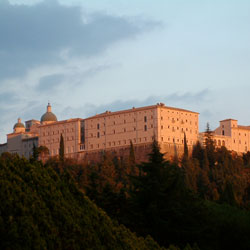 |